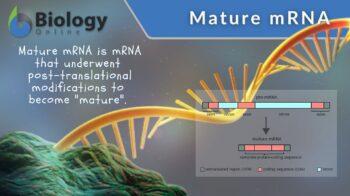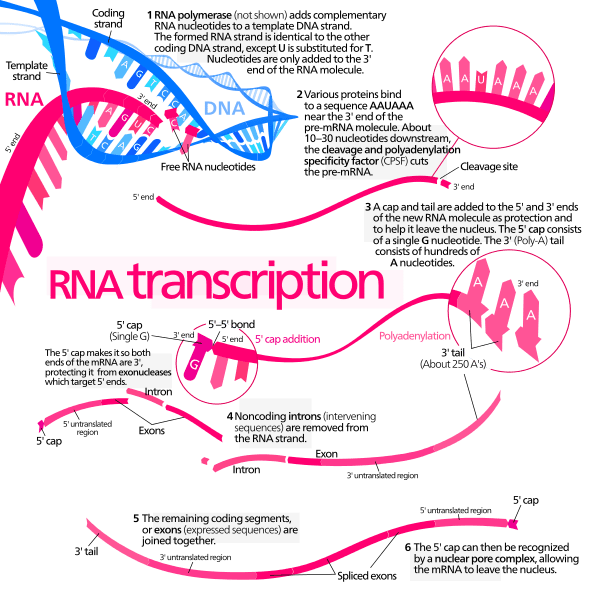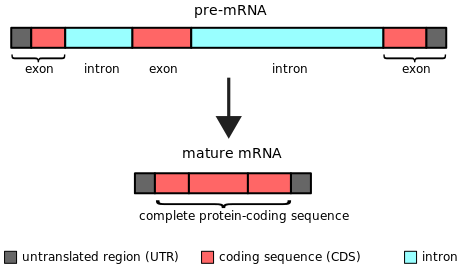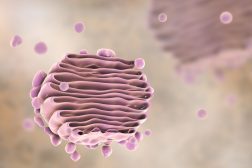
Mature mRNA
n., plural: Mature mRNAs
Definition: mRNA that has undergone post-translational modifications
Table of Contents
Mature mRNA Definition
Mature mRNA is the completely processed mRNA molecule in the cell of eukaryotes. The mRNA is a type of RNA involved in protein synthesis. It is synthesized based on a DNA template on the nucleus. In eukaryotes, it needs to be processed before it can be fully functional, conveying the genetic code to the ribosomes (site of protein synthesis in the cytoplasm). The precursor mRNA (also called pre-mRNA) is the initial form of mRNA in eukaryotes. It is formed by transcribing the genetic information from DNA molecule. Before it is moved into the cytoplasm for translation at the ribosomal site, the pre-mRNA undergoes extensive processing within the nucleus to become mature mRNA.
Variants: mature messenger ribonucleic acid; mature messenger RNA
Compare: precursor mRNA
Mature mRNA Characteristics
Mature-mRNA (often refers to simply mRNA) is a single-stranded nucleic acid. It is the type of RNA that encodes at least one gene and later translated into a protein. It is derived from the pre-mRNA, which is created through transcription prior to translation process. The pre-mRNA undergoes maturation to become mature mRNA. The pre-mRNA differs from a mature mRNA in including both exon and intron sequences. In mature mRNA, these sequences are removed. A mature mRNA can be further distinguished from the pre-mRNA by having a Poly(A)tail added to the 3′ end of the RNA and a 5′ cap added to the 5′ end.
Mature mRNA Biological Function
The mature mRNA carries the genetic blueprint or the code for a protein that is subsequently created by working in unison with tRNAs and the ribosome. It is derived from pre-mRNA after it has undergone post-transcriptional modifications. After processing, the mature-mRNA is transported from the nucleus to the cytosol where ribosomes are located. The ribosomes, together with tRNAs, decode the message that mRNA carries and create protein(s) accordingly.
Mature mRNA Synthesis
mRNA begins being a precursor mRNA (pre-mRNA), i.e. an immature mRNA molecule that is transcribed by the RNA polymerase and goes through further processing to become a functional mature mRNA. To initiate pre-mRNA synthesis (via transcription), the double helices of DNA are first unwound by breaking the hydrogen bonds that connect complementary base pairs. One of the two DNA strands serves as a template for precursor mRNA synthesis. The template strand of the DNA is referred to as the antisense strand.
To initiate transcription, the enzyme RNA polymerase traverses the DNA template strand from 3′ → 5′. However, the copying proceeds in the 5′ → 3′ direction, similar to DNA replication. Nonetheless, unlike DNA replication, transcription does not need a primer to start. Also, it utilizes uracil-adenine base-pairing instead of thymine-adenine (as in DNA replication).
In eukaryotes, there are distinct types of RNA polymerases that are involved depending on the type of RNA to be synthesized. In particular, RNA polymerase II is the type of RNA polymerase involved in the synthesis of pre-mRNA.
In prokaryotes, only one type of RNA polymerase is involved in the synthesis of all RNAs. Furthermore, transcription in the prokaryotes occurs in the cytoplasm whereas in eukaryotes it takes place primarily in the nucleus before the mRNA is transported into the cytoplasm for translation.


mRNA synthesis steps
In summary, the general steps of transcription (mRNA synthesis) are as follows:
- RNA polymerase and certain transcription factors bind to the promoter region of the DNA.
- A transcription bubble forms as the helical DNA unwinds and separates as a result of the breakage of hydrogen bonds between complementary nucleotides. Sigma factor binds to the unpaired nucleotides.
- RNA polymerase adds RNA nucleotides that complement the nucleotides of one DNA strand. Take note that only one of the two DNA strands will serve as a template for transcription, i.e. the antisense strand of DNA of which the RNA polymerase will read from the 3′ end to the 5′ end (3′ → 5′) while the mRNA is created in the opposite direction, i.e. 5′ → 3′. Four distinct ribonucleoside monophosphate residues are used to create pre-mRNA: adenosine monophosphate (AMP), cytidine monophosphate (CMP), guanosine monophosphate (GMP), and uridine monophosphate (UMP). These residues are added to the 3’hydroxyl group on the 3′-end of the growing mRNA. The result is an mRNA transcript that matches the sequence of the non-template sense strand (also called the coding strand) except for thymine, which is replaced by uracil.
- Ribose sugar-phosphate backbone forms as the mRNA transcript forms.
- The newly formed mRNA transcript is freed when the hydrogen bonds between the nucleotides of RNA and DNA are broken.
- The pre-mRNA undergoes post-translational modifications, such as capping, splicing, and polyadenylation, to become fully functional mature mRNA that may be transported into the cytoplasm through the nuclear pore.
Watch this vid about processing of mRNA:
Regulators of transcription
A number of factors regulate the process of transcription. One of them is the transcription factor. Transcription factors are proteins that bind to DNA, particularly to the so-called enhancers (i.e. DNA sequences that promote the transcription of genes and are located farther up or downstream from the genes they regulate). Some of the transcription factors could activate transcription while others could inhibit the process. They do so by recruiting particular enzymes that could either enhance or repress the access of RNA polymerase to DNA.
Silencers are DNA sequences that repress the transcription of genes. Similar to enhancers, the silencers are located father up or downstream from the genes they regulate. They inhibit transcription by binding to certain transcription factors and then working together in destabilizing the initiation complex that activates RNA polymerase.
Take the Mature mRNA Biology Quiz!
Further Reading
© Biology Online. Content provided and moderated by Biology Online Editors


